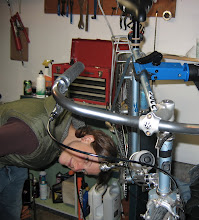
In the seeding / planting phase, the ref. books are out on the bed, floor, or kitchen table more often than they are in the book shelf. During the planting process, there are a few books I turn to for ideas and advice. The first and most beat-up one is 'The Bountiful Container' by Rose Marie Nichols McGee and Maggie Stuckey. This is a container plant book for the pacific northwest- very useful in the seattle area where urban gardening prevails and containers are a great solution to the particular issues of small spaces and northwestern picky growing conditions. I also frequently buy seeds from Nichols Garden Nursery because they have reasonable prices, a low handling fee, and some neat-o seeds.
Next on the list is the original Mel Bartholomew 'Square Foot Gardening' book. He recently came out with another edition, though I fell in love with the 1st ed. Basically, the seed starting methods of putting a single seed in the ground at the spacing eventually they will grow successfully at was born from reading this book. Who knew that you don't need to do the traditional 'plant a row then thin' and use the whole packet of seeds in one go for only 12 to 40 productive plants? Seeds come in packet amounts that will never be consumed or grown by the home gardener, and when handled well will keep for years. Mel has some great tips for frugality and ease, and by not having to thin his methods are great for the sympathetic gardener.
Also greatly important is 'Carrots love Tomatoes'. Louise Riotte's book takes the gardener through garden techniques, pest control, poisonous plants, companion planting, uses and herbal remedies for herbs, veggies, wild plants, weeds, grasses/grains/field crops, fruit growing, ornamental trees / shrubs, I wondered why my snap peas were tremendously successful in one spot of the garden and never took off in another, and this book possibly uncovered the mystery easily- onions and garlic aren't great buddies of peas, snap or bush. I use it to figure out what will go together in containers, and what combinations to avoid closely in the limited garden space I have.
Last ref book is Jill Severn's 'Growing Vegetables in the Pacific Northwest'. Granted the copyright date is 1978, so no fancy new varieties are included, but the basic advice offered is sound and gardening is broken down by how to start up, prep the soil, keep things disease free, then each p.n.w. veggie is broken down by when / how to plant and harvest. A good ol' fashioned book of gardening.
Also I have been checking out the KUOW greendays garden panel on Tuesdays at 10a, and the www.digginfood.com and www.yougrowgirl.com websites for great advice on gardening.








